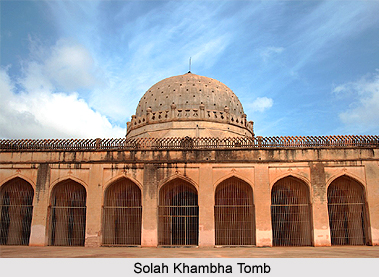 Built during the reign of Aurangzeb, the Solah Khamba tomb was named so because of the 16 pillars that supported its roof. Located just outside the Dargah Sharif in Ajmer, the tomb is widely known to be the mausoleum of a saint called Sheikh Ala-al-Din. He was the saint, who was the overseer of the shrine of Khwaja Moin-ud-din Chisti. His tomb building is located on the western side of the shrine of Khwaja Moin-ud-din.
Built during the reign of Aurangzeb, the Solah Khamba tomb was named so because of the 16 pillars that supported its roof. Located just outside the Dargah Sharif in Ajmer, the tomb is widely known to be the mausoleum of a saint called Sheikh Ala-al-Din. He was the saint, who was the overseer of the shrine of Khwaja Moin-ud-din Chisti. His tomb building is located on the western side of the shrine of Khwaja Moin-ud-din.
Architecture of the Shola Khamba Tomb
The Shola Khamba Tomb is a rectangular building measuring about 40 X 20 metres. The tomb has a total of 3 domes resting on top of 16 pillars. Earlier there used to be a fretted stone parapet round the pillars but is now in complete ruins. The tomb contains 5 graves. A slab of marble has been fixed over the middle arch of the edifice facing the eastern side at a height of almost 11 feet. The marble bears a Persian inscription, which is in Nastaliq script. It refers to the construction of the tomb by Sheikh Ala-al-Din in 1659 AD.
The edifice of the tomb has been constructed using white marble and has arches with four slender minarets arising from each corner. The most distinguishing feature of the architecture is the trio of cusped arches that leads to the flat roof. The courtyard plan has a portico at its eastern side. The main building has a roof space of 1399 sq ft while the portico has an area of 1001 sq ft. The shafts of the columns are octagonal in shape and each 13 inches in diameter. The arches between the groups of columns have similar designs. Black marble designs are visible at the end of piers in the northern and southern facades and on top of the groups of 4 columns. The work has however, been left incomplete. An inscription has been engraved on the eastern wall of Solah Khambha Tomb that states that Ala-ud-Din was a descendant of Khwaja Moin-ud-din Chisti who died at the age of 75 years in 1660 AD. He was a religious dignitary during the period of Emperor Shah Jahan. Ala-ud-Din`s tomb has been fixed on the wall in the north eastern direction. At each angle there are 4 columns of the chhatri which rest on a slab. This forms the base for the chhatri. These are placed on 2 stone cut across the wall at right angles. The wall is only a span board hence the chhatri is known as "ek balisht ki chhatri".
Visiting Information on the Shola Khamba Tomb
The nearest airport is at Jaipur, while the Ajmer railway station is at a mere distance of almost 1 km from the tomb.



















